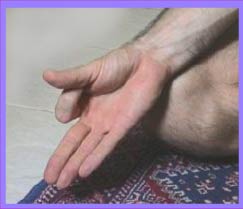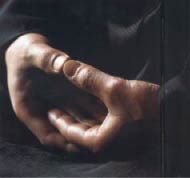The Mudras
During millenniums, the technics of Yoga reserved to disciples, were kept carefully secret. The Mudras are part of these technics whose effects are not always intended to the beginner. A Mudra is a "seal", a sacred gesture whose objective is to lead to
– a psychological attitude.
– an energizing effect.
– a spiritual experience.
The first Mudras have been described in the Gheranda Samhita. They can be merely the very precise gestures that one makes with the fingers or the hands, (Jnana Mudra, Chin Mudra, etc.).
– They can be gestures made with other parts of the body very localized as the eyes, the nose, (Shambhavi Mudra, Nasikagra Drishti Mudra, etc.)
"For those that are heedful, and of which the mental is concentrated on only one point in samadhi, Shambhavi mudra is the biggest mudra that can confer the perfection (Hatha-Yoga Pradipika 3 verse 125)"
– They can be some stances where one combines the asanas, the pranayamas and the bandhas (Maha Beda Mudra, Akashi Mudra, etc.)
In the Indian dance, we find also some mudras, in general, different from hatha-yoga, so that the dancer can evoke a particular feeling.
The goal of yoga is all other.
The mudras can, beyond the faculty to evoke an attitude of the mind, to act on the Nadis in order to reorient the Prâna. It is already a level more advanced. So besides, they are practiced with the repetition of mantras, then their power will be multiplied. This is how one will find some mudras for the recovery, to act on an event, to make push some plants, and a lot of other possibilities again.
As for the mudras combined with the stances, they have the power to act on the chakras and to awaken the kundalini. Their object is essentially spiritual.
An example of Mudra: Jnana Mudra

Jnana means knowledge, mudra means gesture. "Jnana Mudra" is therefore the "gesture of the knowledge."
– The symbolic of the Hand in the Jnana mudra.
- The inch represents Brahman, (cf Vedanta) what is qualified in, without name nor shape, the absolute.
- The index represents Ahamkara, the ego. (I am the most beautiful, the strongest, the most intelligent! )
- The last fingers represent the "3 Gunas", (cf Samkhya)
-
- The adult represents Sattva, the elevation, the purity, the subtle.
- The ring-finger represents Rajas, the passion, the action.
- The auricular represents Tamas, the inertia, the dark, the coarse.
– Description of the mudra: the index is folded to the root of the inch and the three other fingers are stretched, palms of the hands turned skywards, the hands on the knees.
– The global sense of Jnana mudra. "By the work of Yoga, I learn to uproot the ego while inclining me before what is superior (you put what you want there), and by the mastery of the techniques, I learn to transform the coarse in subtler." Jnana Mudra is the necessary gesture for the opening of a Hatha-yoga course in order to prepare the body and the mental of the student to concentrate on the practice that is going to follow.
For the meditation, "Dhyana mudra" as for him, permits the contemplation of the mind.

Hari Om Tat Sat

